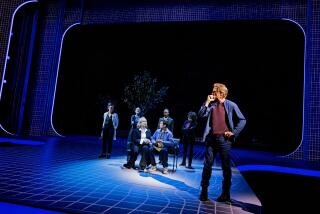Dramatist Donald Margulies sees the stage in a fresh light
More than a quarter century ago, the critic Robert Hughes called the public’s response to Modern art “the shock of the new.” The role of art was to stimulate ideas, provoke thought, challenge ways of seeing. Today, we are experiencing a different, troubling phenomenon: a popular culture that embraces the comfort of the familiar.
Americans discovered the hard way that we don’t like surprises. Now that fear and uncertainty have taken permanent residence, people are unnerved by ambiguity in all aspects of life. They look for reassurance in rituals that are concrete and predictable.
Newness is suspect. Constancy is rewarded. The consumer will go to McDonald’s expressly for its Big Mac, go home satisfied, and make repeated return visits for the same reliable product. The fast-food culture now extends to the entertainment industry. Here the consumer has a pretty good idea what he’s going to see before he sees it, and seems to prefer it that way. How else do we explain the proliferation of movie adaptations onstage and the domination of the franchise in the world of motion pictures?
Movie franchises promise plotlines that rely on tried and true formulas, and reunions with characters who, over time, seem like old friends. There is little surprise and no real jeopardy because these heroes are invincible: Bourne/Bond will surely endure because too much rides on his appearing in the next installment.
Serials, of course, are nothing new; they have been a part of the moviegoing tradition from the earliest days of the medium. But nowadays they have become industries unto themselves. They are pre-sold products with instant name recognition and built-in audiences; and the public, pressed to put their limited leisure time and entertainment dollars to good use with as little risk as possible, will invariably choose to spend their time and money on the sure thing.
Can we blame them? A night at the movies for a family of four, once you factor in parking, popcorn and that personal liter of Coke, could easily approach $100; a night on Broadway for the same foursome could cost more than five times that. Is it any wonder consumers want to know what their buck will get them before they plunk it down at the box office?
Today’s theater-going audiences can hum the “score” of “Jersey Boys,” the Four Seasons musical, before they enter the theater; they can anticipate the best lines from “Legally Blonde: The Musical” and know Celie’s fate before the curtain comes up on “The Color Purple.” They howled at their favorite shtick in Mel Brooks’ “The Producers” and are likely to do the same with his “Young Frankenstein.” The good financial news is that Broadway had a record-breaking year, but you know we’ve turned some kind of cultural corner when the once-subversive Monty Python can be repackaged for mainstream audiences as a benign greatest-hits extravaganza. (A notable exception to this recycling trend in musicals is the fresh and challenging “Spring Awakening,” whose source is a dark, 19th century text by Frank Wedekind unknown to but a handful of its potential audience.)
Even non-musicals derived from popular films have made their way to the commercial stage: “The Graduate” gave certain aging actresses a chance to show they still looked good with their clothes off (and sold a surprising number of tickets to the curious) and now “Guess Who’s Coming to Dinner?,” the soothing racial comedy-drama from the ‘60s, is also headed for Broadway.
Pity the poor dramatist living in an age in which movies have opening dates before they have scripts, television eschews scripts altogether in favor of contrived “reality” programs and Broadway has been reduced to a theme park where theatergoers can see some of their favorite movies performed live.
Dire pronouncements about the moribund state of the American theater have been made for decades but, like the formerly remote concept of global warming, there is every indication that its demise has finally come. The audience for “serious” theater (straight plays) is dwindling. The subscriber base -- the life force of not-for-profit theaters for half a century -- is literally dying, and the next generation is not filling their seats.
That group, the aging boomer, is too consumed by the demands of their careers, putting their kids through school and caring for their failing elders (those vanishing subscribers) to make theater-going the vital part of their lives that it was for their parents.
Young people have so many options at their fingertips that the plight of the theater must seem almost quaint to them, certainly irrelevant. How can theater, with its technologic limitations, possibly compete with the vast arsenal of entertainment available to them?
Age of the idle viewer
Spectacular computer-generated graphics have made imagination redundant. The creative energy expended is that of the artist; the viewer is made utterly passive. Nothing is required of him but to sit back and receive a seemingly endless barrage of fantastic images, a sensory assault that comes at him so quickly he barely has a chance to sort them out. The collateral damage of all this technology is the atrophy of imagination. Audiences are losing their ability to supply imagery of their own design and are becoming increasingly concrete in their thinking.
I was at the movies recently, in the company of two media-savvy teenagers. During the numbing onslaught of trailers (I can’t tell you what they were for, they’ve all melded in my memory as one noisy, ugly, ultraviolent, would-be blockbuster), a special effect flashed by: cars flipping through the air, crashing and exploding into a fireball, that sort of thing. My companions were unimpressed.
“Oh, man, that looks so fake,” one said, and they both laughed.
Their derision saddened me. Have we so inundated our children with technical wizardry that they’ve lost their capacity for wonder? Have computer-generated armies of thousands and intergalactic conflagrations become so commonplace that they feel they can dismiss an effect if it fails to meet their high standard? I think we’ve all lost something precious when effects that might have thrilled earlier generations to death are derided by today’s young pseudo-sophisticates as feeble attempts.
I watched a lot of television when I was young, and remember being enthralled by series such as “Star Trek” and “I, Claudius.” I went willingly to wherever they took me, whether it was outer space or ancient Rome, and never stopped to weigh their production values. When I watched those programs again recently I was amazed by how endearingly cheesy they were. Their sound-stage origins were barely disguised but I don’t remember ever remarking on their artifice. I was too invested in the characters and the stories being told to notice, let alone care.
The oral tradition of storytelling was perhaps best exemplified by the radio play. Stories came to life through sound, music, voice, descriptive language. The listener’s imagination did the rest.
Orson Welles’ Mercury Theatre radio production of H.G. Wells’ “The War of the Worlds” famously terrified its audience into thinking that a Martian invasion had taken place in Grover’s Mill, N.J. (It was so persuasive that, according to family lore, my Aunt Pauline wailed, “And we just bought new furniture!”) Contemporary listeners would probably find the performance too stagy to be believed, but its 1938 audience, still reeling from the Depression, readily suspended its disbelief. It was all too plausible that their tenuous lives could be taken away from them, even by marauding Martians. Welles and company knew the seductive power of a good story and innately understood the potential of electronic media as theater on a grand scale.
A way to relate
The magic of theater is its power to astonish, but astonishment can occur only if the audience is willing to suspend its disbelief. How are we expected to astonish young people who have seen everything imaginable, on screens of all description, since they were born?
We need to build a new tradition of theater-going if the theater is to survive. The challenge is to invite this potential audience into the theater, to entertain and move them and make them laugh. If we do our job well, they’ll come again and keep coming, and one day bring their children. If we don’t, if we bore or alienate them, we could lose them forever.
How often have you gone to a play, even a highly touted one, only to be bored? You’ll forgive a bad movie, which can be amusing even in its badness, but sitting through a bad or tedious play can be punishing. You’re trapped, at least until intermission, and you resent being trapped. You sit there festering about all the money you spent, and the damn critics who said this was good, and the episode of “Mad Men” you could have been watching on TiVo for free in your own living room.
My aim with “Shipwrecked! An Entertainment -- The Amazing Adventures of Louis de Rougemont (as told by himself)” was to capture the attention of the hidden child in everyone in my audience. I wanted to write a play that would make no attempt to replicate onstage what television and movies do but would instead celebrate the uniqueness of theater. My impulse was to strip away the trappings of spectacle and get back to what theater does best: tell stories that reflect our world or create new ones that can enlighten, amuse, transport, make you forget, or force you to remember.
I set out to tell a ripping good yarn, the sort of narrative that captivated me when I was a boy, that I think enthralled all of us. For my subject, I was drawn to a story about the very nature of storytelling.
A few years ago, while researching a movie I was writing about a Holocaust survivor-pretender, I read the book “Impostors” by Sarah Burton. In it was the curious true-life tale of Louis de Rougemont, a man whose exploits transfixed the Victorian public. Louis claimed to have survived, among many other travails, a spectacular shipwreck in the South Seas, an attack by a giant octopus and 30 years among a tribe of cannibals. His serialized story made him famous, a celebrity author not unlike the Oprah Winfrey-annointed James Frey, whose veracity (like Frey’s) was ultimately called into question. Louis’ story stayed with me. In fact, the Frey controversy reawakened my interest in it. (Frey wrote “A Million Little Pieces,” a memoir that turned out to be significantly fabricated, for which Frey was publicly dressed down by his erstwhile patroness.)
The story of Louis de Rougemont, his rise and fall, had all the elements of a classic picaresque: A young man leaves home to find himself, goes on a long and unpredictable journey, survives extraordinary events, finds fame, tells lies. In it I saw the potential for a purely theatrical play about the power of imagination.
Whenever I start contemplating a new play, I re-read one of my favorites, Thornton Wilder’s “Our Town.” Revisiting Grovers Corners has become a ritual of mine, like cleansing one’s palette with sherbet between courses. Every time I read it, I make new discoveries. For this new play, “Shipwrecked!,” I found inspiration in its very first words:
“No curtain.
No scenery.
The audience, arriving, sees an empty stage in half-light.”
Margulies’ other plays include “Brooklyn Boy,” “Sight Unseen” and “Collected Stories.” He won the 2000 Pulitzer Prize for drama for “Dinner With Friends.”
‘Shipwrecked! An Entertainment’ Where: South Coast Repertory, 655 Town Center Drive, Costa MesaWhen: 7:45 p.m. Tuesdays to Fridays, 2 and 7:45 p.m. Saturdays and SundaysEnds: Oct. 14Price: $20 to $62Contact: (714) 708-5555
More to Read
The biggest entertainment stories
Get our big stories about Hollywood, film, television, music, arts, culture and more right in your inbox as soon as they publish.
You may occasionally receive promotional content from the Los Angeles Times.










